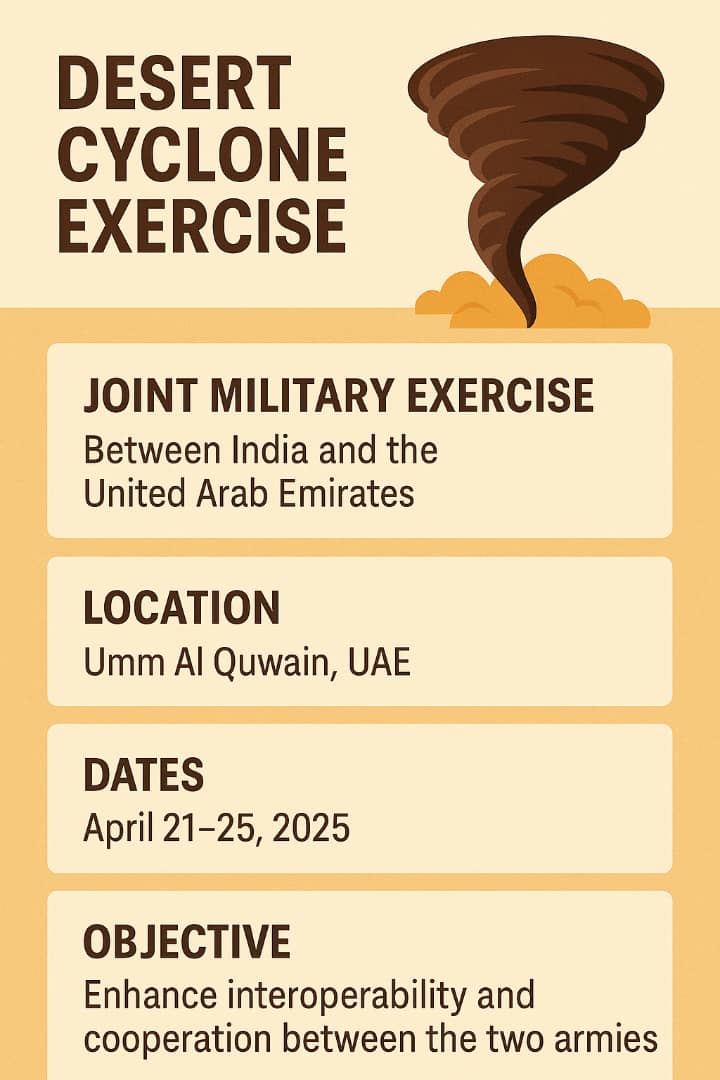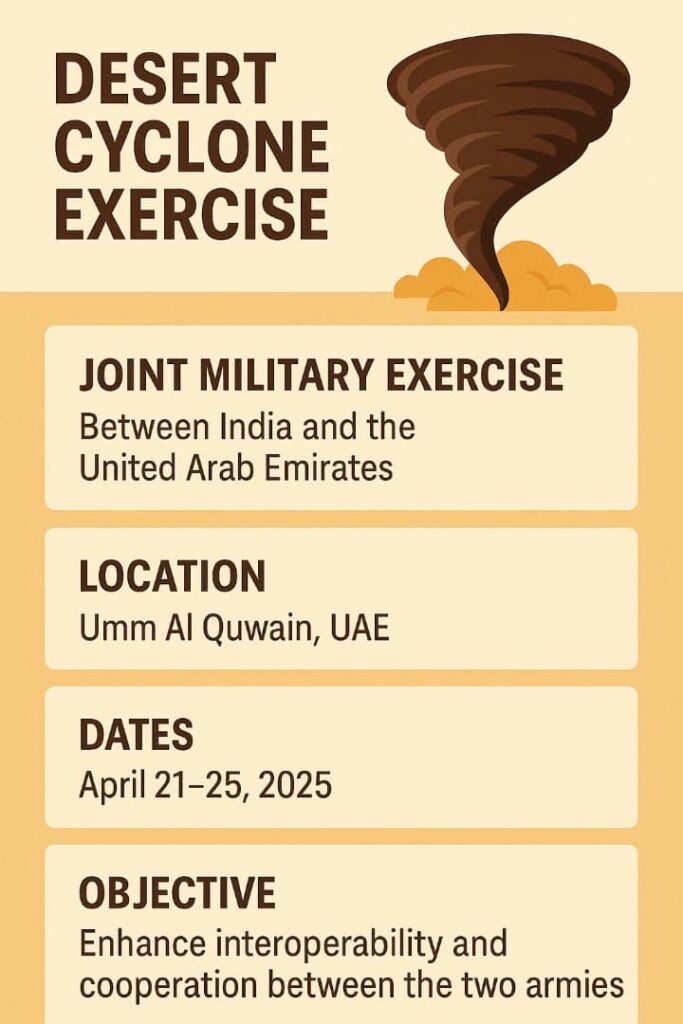As today’s world becomes ever more connected, with exercises serving as crucial tools for nations to solidify or reinforce their alliances and strengthen their defence posture, joint drills like the Desert Cyclone Exercise are becoming more common.
Beyond its military display, the Desert Cyclone represents a deepening of ties, an operational readiness, and a cooperation against changing security challenges in the region.
So, Desert Cyclone Exercise usually means a joint military exercise between India and the United Arab Emirates (UAE), which has a harsh desert landscape in the Middle East. Beyond testing military endurance, the exercise also poses significant opportunities for tactical interoperability, counter-terrorism rehearsal, and combined force coordination.

Summary
The following blog post provides an overview of the Desert Cyclone Exercise, covering its genesis, strategic significance, objectives, operational context, and broader geopolitical context.
Historical Context and Origins of the Desert Cyclone Exercise
The Desert Cyclone Exercise is a recent, but not unprecedented, addition to the catalogue of international military collaborations. India and the UAE conceptualized the bilateral joint military exercise in the early 2020s, reflecting their deepening defence ties.
The two countries, sharing common threats of terrorism, piracy, and regional instability, based the idea for the joint desert exercise on their increasingly strategic convergence.
India has enjoyed a warm relationship with the UAE, particularly through trade, energy cooperation, and a sizeable Indian diaspora living in the Gulf for decades.
However, in recent years, the relationship has developed into a more profound security partnership. Desert Cyclone Exercise was being held in the United Arab Emirates for the first time with troops from both sides participating in various tactical scenarios covering the vistas of desert warfare, Urban Combat, and Counter-Insurgency Operations.
Objectives of the Exercise
The exercise takes place in a Plan 20 format at multiple levels, aligning with strategic-tactical goals. These include:
• Interoperability: The first goal is the enhancement of interoperability, which, in layman’s terms, means ensuring seamless coordination and cooperation. This includes collaborative planning, joint military actions, and coordinated formations of troops.
• Desert Warfare Training – Desert and Extreme Heat Survival: The exercise forces troops to acclimate to extreme temperatures, sandy ground, and conditions with little visibility.
• Mock Operations: A key aspect of the exercise includes mock operations against mock terrorist enclaves. These exercises go a long way to ensure the troops will be ready for whatever the enemy throws at them, including asymmetric warfare.
• Urban Warfare and Hostage Rescue: Certain parts of the exercise take place in simulated urban environments for hostage rescue, close-quarter battle and riot control scenarios.
• Military Tech: The war plays a nodal testing ground for modern warfare devices—drones, night-vision gear, GPS tracking, AI-led resolution tools.
Who Are the Participants & Forces Involved?
Elite forces from both countries usually attend the Desert Cyclone Exercise. Troops from the Para Special Forces or the Mechanized Infantry Regiment, among others, usually take part from the Indian side. These units receive training for quick-response, high-mobility missions and guerrilla warfare.
On the UAE side, the country’s armed forces are generally represented by the Presidential Guard and specialised desert units trained in conventional and irregular warfare. These troops expertly handle desert operations and frequently train to NATO standards.
Other friendly nations may also have either observers or liaison officers embedded in the exercise, suggesting a multilateral interest in regional security cooperation.
Format and Stages of the Exercise
Desert Cyclone Exercise is a multi-phasic exercise, scheduled from one to two weeks. The stages involved can look something like this:
Phase 1: Getting Started
• Initial briefing sessions
• Acclimatisation to the environment and equipment
• Mission simulations and joint planning exercises
Phase 2: Tactical Maneuvers
• Joint patrols and reconnaissance operations
• Convoy movements under simulated hostile conditions
• Construction of Forward Operating Bases (FOBs)
Phase 3: Counter-Terrorism Operations
• Fake terrorist attacks in fake villages
• Mandatory house-to-house searches and room-clearing exercises
• HVT capture and extraction
Phase 4: Urban Warfare
• Training in Close-Quarters Combat (CQC)
• Riot control simulations
• Decision-making and mistake recognition in real-time scenarios
Phase 5: Evaluating and Debriefing
• Joint commanders performance evaluation
• Feedback on tactical and strategic level
Geopolitical Context and Strategic Importance
India’s Perspective
One is India’s growing involvement in Middle Eastern geopolitics as part of its “Act West” policy. The Desert Cyclone Exercise enables India to showcase its soft power, consolidate defence ties and secure security cooperation in a region that is vital for energy security and economic linkages.
Moreover, millions of Indian citizens live and work in the Gulf region, as do significant investments from Indian businesses. A secure Middle East secures India’s long-term strategic interests.
UAE’s Perspective
Traditionally, the UAE’s defence partnerships have favoured Western allies such as the United States and France. Nevertheless, the deepening cooperation with India is in fact a diversification of its strategic partnerships. India represents a credible partner on regional counter-terrorism, cybersecurity and maritime security.
Regional Dynamics
The Middle East is a volatile terrain, with wars continuing to unfold in Yemen, Syria and parts of Iraq. To counter Iran’s regional aggression, maritime piracy across the Arabian Sea and threats by non-state actors, it requires a well-connected web of defence partnerships. In this way, the Desert Cyclone Exercise is part of a broader web of security in the region.
Innovation: Technological and Tactical
One of the main components of the Desert Cyclone Exercise is modern military technologies. These include:
• Drones: For surveillance and tactical strikes
• Cyber Warfare Modules: Cyber defence, data encryption, network security
• AI-Enabled Targeting Systems: Combat zones that reduce human error
They serve as the nerve centre for joint command-and-control systems — real-time communication tools that enable synchronized maneuvers.
These technologies are essential to modern warfare; battles are increasingly fought and won through superior intelligence and faster ability to adapt.
Generalization of Soft Diplomacy and Cultural Exchange
Although the Desert Cyclone is a military exercise, it also doubles as a venue for cultural exchange and soft diplomacy. It is common for soldiers from both countries to participate in sports, cultural nights, and story sessions in such non-combat settings. These activities encourage friendship and respect for each other.
Those human relationships amplify the exercise’s long-lasting effects and forge connections that extend past the battlefield.
Dependability, Difficulties and Logistical Intricacies
Conducting a multinational military exercise in a desert environment poses its own set of obstacles:
• Extreme Climate: Extreme weather conditions such as searing temperatures, swirling sandstorms, and dehydration
• Logistics: Moving people, vehicles and equipment from one country to another takes careful planning
• Language Barriers: Even if English is widely spoken, it can lead to communication gaps
• Security threats: Because of the proximity to war theatres, greater security measures are required
Notwithstanding the hurdles, Desert Cyclone Exercise indicates the professionalism and preparedness level of both armies.
How the Media Framed the Killings and Public Reaction
National and international media regularly cover the Desert Cyclone Exercise. The coverage highlights defense cooperation, counter-terrorism preparedness and diplomatic bonhomie.
• In India: The exercise is framed as a sign of India’s rising global influence and military diplomacy
• In the UAE: It speaks to the nation’s pledge to act as a regional security provider and a modern military power
Positive public reception in both nations interprets the exercise as a demonstration of peace, preparedness and partnership.
Growth Opportunities and Enhancement
Desert Cyclone Exercise can grow into a multilateral drill with more nations from South Asia and the Gulf. Here are some potential future developments:
• Naval and Air Force Components Integration: Beyond just the army, to incorporate multi-services working in a coordinated manner
• Global Presence: Invitees include nations such as Saudi Arabia, Egypt, or France
Such expansions would not only augment the strategic utility of the exercise, but would also promote wider regional stability and cooperation.
Conclusion
The Desert Cyclone Exercise is a milestone in strengthening military and strategic ties between India and the UAE. It is also a response to the shifting landscape of international relations, where regional powers assume greater responsibility for their security environments.
More than a series of military exercises, the Desert Cyclone is a cultural bridge, a training ground for future wars and a testing ground for technology. Geopolitical uncertainties are likely to remain, and such exercises will be increasingly relevant in achieving peace through preparation.
From a strategic, operational, and diplomatic perspective, the Desert Cyclone Exercise serves as a model of how modern military cooperation can be operationally rewarding and sustainable.







